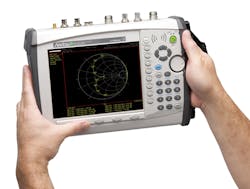Portable RF Test Equipment Follows the Lead of Bench-Top Instruments
Over the last few years, the wireless industry has observed the capabilities of bench-top test equipment gradually trickling down into portable and handheld instruments. In particular, it has become standard for test equipment manufacturers to incorporate a number of additional test functions into both bench-top and portable instruments.
Now, according to a recent report from Frost & Sullivan, a research firm that examines the microwave and RF test equipment market, it seems that the market for portable RF test equipment is responding to these improvements. The report predicts that the market for portable and handheld microwave and RF test equipment earned revenues of around $2.26 billion in 2014 and will earn approximately $2.92 billion in 2020.
Because most of the requirements remain the same from what might be expected from a bench-top instrument, the report notes that portable testers are being built with additional functions to address more complex wireless systems. Handheld spectrum analyzers, for instance, have evolved not only to support higher frequencies, but also to test a large number of modulation techniques and wireless standards like LTE-A, EDGE, and W-CDMA, among others.
“Handheld testers are selected based on application, accuracy, environments, size and battery life but leading manufacturers are also striving to achieve bench-top accuracy,” says Prathima Bommakanti, an analyst with Frost & Sullivan’s measurement and instrumentation division. In spite of these intentions, portable test equipment still lags behind its laboratory counterparts in certain parameters, including dynamic range, sensitivity, noise floor, speed of test, or repeatability.
The Rohde & Schwarz FSH Handheld Spectrum Analyzer, for instance, also functions as a power meter, a cable and antenna tester, and a two-port vector network analyzer. At the same time, it supports a frequency range between 9 kHz and up to 20 GHz on the most advanced model, plus 20 MHz demodulation bandwidth for analyzing LTE signals. Other instruments from Anritsu, Tektronix, Keysight Technologies, and Thurlby Thandar Instruments have similarly integrated spectrum analyzers.
Portable test equipment is growing in demand as wireless companies expand the installed base of wireless access points. These companies are forced to test multiple points on their wireless networks to maintain quality service, says Bommakanti. With support for a wide range of technologies, portable RF testers have also become more attuned to more heterogeneous nature of wireless infrastructure.
"Portable spectrum analyzers are best used in spectrum-management applications. Performing spectrum mapping and chasing down interference signal needs to be done quickly, and often involves drive tests where portability can be critical,” said Richard Duvall, former technical marketing manager for Tektronix, currently working as a senior marketing manager at Kollective Technology, in an article from Microwaves & RF magazine last year.
The report notes that new test functions are only adding to the allure of portable test equipment: These instruments have typically been favored for lower costs, greater versatility, and simple maintenance when compared to bench-top instruments. Manufacturers have begun to incorporate touchscreens for simpler use and increased versatility with longer battery lives. Battery-operated instruments can even be used in remote environments through Android and Apple phones and tablets.
“All said and done, handheld devices have lower costs than other technologies, and are easy to maintain,” says Bommakanti. He notes that field personnel and smaller industrial companies are more focused on these aspects “than the sophistication of emerging or bench-top technologies.”
About the Author

James Morra
Senior Editor
James Morra is the senior editor for Electronic Design, covering the semiconductor industry and new technology trends, with a focus on power electronics and power management. He also reports on the business behind electrical engineering, including the electronics supply chain. He joined Electronic Design in 2015 and is based in Chicago, Illinois.
